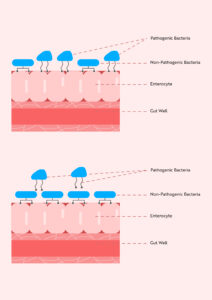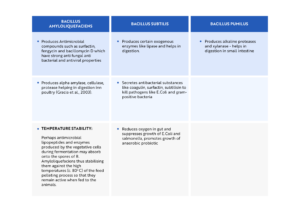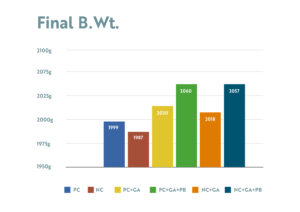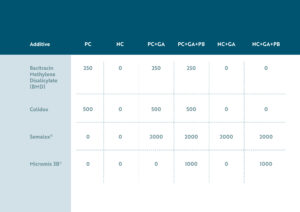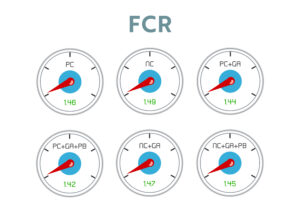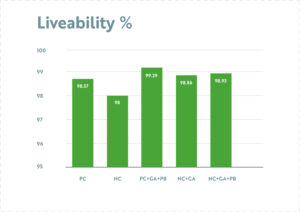Currently, the animal feeding practice includes prophylactic approaches for supporting intestinal health and immunity, to reduce the incidences of dysbiosis, diseases, and the need for antimicrobial medication. The antibiotics kill the pathogen or restrict their multiplication to control the infection from advancing in the host. As per the report of the World Health Organization, the increased and inappropriate use of antibiotics leads to the development of antibiotic resistant bacteria.(WHO 2005).
To avoid this issue people started using alternative antibiotic growth promoters like probiotics, prebiotic, symbiotics, and other herbal products. While probiotics either single strain or multiple cultures of living microorganisms are administered in adequate numbers, exert health benefits. improving the host intestinal microbial balance, enhancing colonization beneficial microbes against pathogens and improving the immune responses(Kabir et al., 2009)
How does it work?
- Maintain a healthy balance of bacteria between beneficial bacteria by exclude potential pathogenic bacteria through competition for attachment site in the intestine
- Inhibit the growth of pathogenic bacteria by producing lactic acids by probiotic
- Modulating the immune system and preventing inflammation (Yang and Choct, 2009) of the gut epithelium
Reasons why Bacillus species are superior probiotic feed-additives for poultry:
Bacillus species produce antimicrobial compounds and form spores.
Spores prolong shelf life, provide protection from heat, UV radiation, desiccation and low pH, such as in the gastric stomach (Riesenman and Nicholson, 2000).
Other major advantages of spores over vegetative (LAB) cells are their thermostability to high temperature; spores can survive at 235°F (113°C) for 8 minutes.
This thermostability property allows incorporating the spores into the feed during the milling and pelleting of the feed and other applications as production of vaccines incorporate as adjuvants. Spores also can be spray-dried.
In addition, spores are resistant to desiccation and other stress factors like bile and low pHs both present in the gastric juice.
Bacillus spores are able to absorb toxins in the GI tract, induce the innate immunological response through interaction with the Toll-like receptors of the host cells (TLR2 and TLR4), stimulating of NF-kb pathway increasing the levels of NK cells, induction of cytokines (IFN-g), improve intestinal integrity and stabilize the microflora, enhance the Daily weight gain (DWG) of the chickens and the Feed Conversion Ratio (FCR).
Other important characteristic of Bacillus ssp. is their genetic potential. Fully sequenced Bacillus ssp. have 3000 to 6000 genes (Big tool box) NCBI Bacillus genomes, whereas Lactobacillus spp. have from 1800 genes to 3000 genes.
Teresa et al., (2005) screened for Bacillus Isolates in the broiler GIT and found 237 Bacillus spp and majorly identified are B. subtilis, B. pumilus, B. licheniformis, B. clausii, B. megaterium, B. firmus, and species of the B. cereus group, whereas a number of our isolates could not be classified.
Bentoli’s R&D team conducted a trial on 1680 straight run Cobb chicks divided in 6 groups with 8 replicates of 35 chciks in each replicate to show and compare the efficiency of Bacillus probiotic consortium ( Micromix® 3B) and gut acidifier (Semalex®) over antibiotic growth promoter.
The group supplemented with Bacillus probiotic consortium and gut acidifier showed responses in average b. wt and mortality percentage similar to antibiotic growth promoter group.
Bottom line:
Perhaps a consortium of Bacillus groups and gut acidifiers would be the preferred option over antibiotic growth promoters to obtain the optimum gut health and gut performance. Bacillus probiotic consortium offers sustainable and prolonged benefits which could be the best suitable option to avoid antibiotic resistance, traceability.
